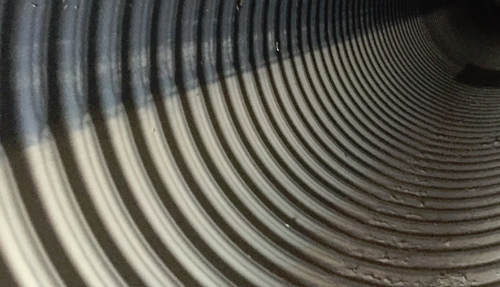
HYDRAULICS FOR GRAVITY SEWER PIPE
A Few Things to Consider
I’ve recently been seeing engineers choosing what I feel are inappropriate Manning’s “n” coefficients for sewer design. Some choose too conservative values, while others don’t understand that long term creep within the pipe wall may adversely affect the hydraulic performance of certain pipe types. A few things to consider are as follows:
- Corrugated Metal Pipe (CMP): Not all CMP has a Manning’s n value of 0.024! This value is mostly attributed to the old style riveted, or annular, CMP. The most common CMP produced today is helically wrapped into diameters ranging from 6” to 144” and larger. The helical nature of the modern CMP allows for much better flow characteristics that can result in much smoother Manning’s n values (e.g. 15” Diameter ½ inch corrugation has a n value = 0.012). More importantly, within the helical family of CMP there exists a unique corrugation referred to as “spiral ribbed” CMP where the Manning’s n value = 0.012 for all diameters provided. A simple chart for guidance is below:
-
Sanitary Sewer: Not all thermoplastic pipes in the sanitary world are equal. Many know that Polyvinyl Chloride (PVC) has a Manning’s n value of 0.009, but they conservatively use 0.012/0.013 based on Reinforced Concrete Pipe’s historical values after adjusting for sliming of the pipe wall and joints. Since PVC is highly resistant to sliming, this is considered as an overly conservative number, but we know it will work.
Many mistakenly think all thermoplastic pipe will have the same Manning’s n value as PVC in the short term and long term. Specifier beware. Some materials, like Polypropylene, have a much lower elastic modulus and tensile strength, can produce laboratory tests showing the Manning’s n = 0.010/0.011, but after installation the inner wall can experience local buckling that dramatically increases n values as high as 0.015 to 0.020. See example picture below:
Polypropylene Sewer Pipe Inner Wall Buckling
- PVC vs. RCP: Many specifiers don’t realize they can possibly reduce their diameters 3” to 6” by using PVC storm sewer pipes vs. RCP. When using Hydraulic Conveyance Values (C1) you get the following tables when using PVC n=0.009 vs. RCP n=0.013 respectively.
C1 Values = (1.486/n) (A) (R2/3)
| Diameter | PVC (C1) | RCP (C1) | Same Diameter Variance | PVC vs 3” Larger RCP Diameter Variance |
| 12” | 51.4 | 35.7 | 144% | 79% |
| 15” | 93.3 | 64.7 | 144% | 89% |
| 18” | 151.7 | 105 | 144% | 96% |
| 21” | 228.8 | 158 | 145% | 101% |
| 24” | 326.7 | 226 | 145% | 105% |
| 27” | 447.3 | 310 | 144% | 109% |
| 30” | 592.4 | 410 | 144% | 89% |
| 36” | 963.4 | 666 | 145% | 89% |
| 42” | - | 1006 | 96% |
You can also consider replacing RCP Pipe Arch with PVC pipe.
C1 Values = (1.486/n) (A) (R2/3)
| Diameter | RCP Pipe Arch Dimension | PVC (C1) | RCP Pipe Arch (C1) | Variance | Distance from invert to top of PVC | Distance from invert to top of RCP P. Arch |
| 12” | 18 x 11” | 51.4 | 50 | 103% | 12.26” | 13.25” |
| 15” | 22 x 13.5” | 93.3 | 84 | 111% | 15” | 16” |
| 18” | 26 x 15.5” | 151.7 | 127 | 119% | 18.35” | 18.25” |
| 21” | 28.5 x 18” | 228.8 | 187 | 122% | 21.67” | 21” |
| 24” | 36.25 x 22.5” | 326.7 | 339 | 96% | 24.55” | 26” |
| 30” | 43.75 x 22.5” | 592.4 | 566 | 105% | 30.81” | 30.63” |
| 36” | 51.13 x 31.31” | 963.4 | 866 | 111% | 37.11” | 35.81” |
Consider these tips when designing your sewer projects moving forward.

